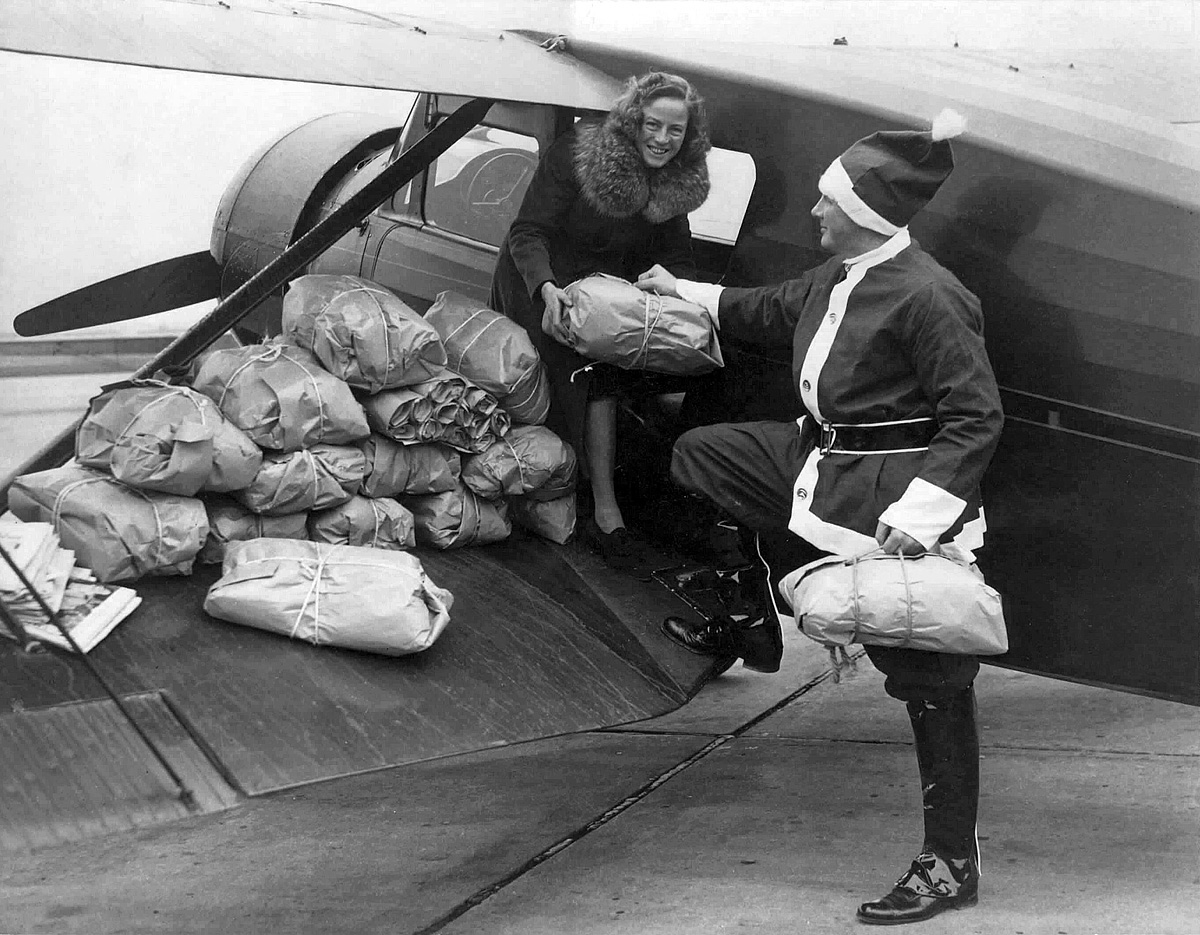Throwback Thursday: When Flying Santa Would Drop Presents to New England Lighthouse Keepers

Edward Rowe Snow and wife Anna-Myrle preparing for a flight. / Photo provided by Friends of Flying Santa
On Christmas day in 1929, pilot William Wincapaw loaded his airplane with gifts and took off, dropping them from high in the air to the hard-working lighthouse keepers of Maine below.
He wanted to show his appreciation for the attendants of the lonely outposts, and ended up establishing a tradition known as Flying Santa. Wincapaw and his son, Bill Jr. continued dropping presents from a biplane for years after. Their radar expanded from Penobscot Bay in Maine to 91 lighthouses along the coast of New England. Over the years, the number of lighthouses, and eventually Coast Guard bases, continued to expand.
When the Wincapaws moved from Maine to the Boston area, Bill Jr. became a student in Edward Rowe Snow’s history class at Winthrop High School. Snow, a distinguished author and New England maritime historian, was interested in Flying Santa, and decided to get involved. Snow took his first flight as Santa in 1936, and eventually took over the program when Wincapaw passed away. Snow flew every Christmas for 44 years, except for when he was wounded in 1942.
“Without a big personality like his, the tradition I think wouldn’t have kept going all these years,” says Jeremy D’Entremont, a maritime historian who helped to update some of Snow’s books.
Snow dropped presents wrapped in newspaper, excelsior (a hay-like material ensuring padding and buoyancy), brown paper, and twine. Packages with magazines, tea, candy, and shaving kits were reserved for adults, and dolls, puzzles, and other toys were for children, along with the latest copy of one of Snow’s books. Snow’s daughter, Dorothy Bicknell Snow, or Dolly, says that each package was marked with a letter: S for stag, since some islands had no women present, D for doll, F for family, and sometimes “DOG,” with dog biscuits enclosed.
Inside the packages, there would be a self-addressed postcard that read “We have received your package.” Bicknell Snow says the postcards her father received enabled him to claim 94 percent accuracy.
Snow’s wife, Anna-Myrle, flew along in the plane, as did Dolly when she was a child. It was an annual trip Dolly despised.
“I had a horrible time,” she says. “It was so rough. It was a five seat plane, and by the time I remembered things—they used to put me in the back with the packages—I was always so sick. I would try dramamine, not dramamine, eating breakfast, not eating breakfast. I just hated it. But I knew it was special.”

Edward Rowe Snow preparing to drop a package. / Photo provided by Friends of Flying Santa
Although “aerial St. Nick” was mostly accurate while zooming at low altitudes, sometimes he missed his target. Several presents dropped into the ocean, through skylights, and onto cars.
In 1945, a doll to meant to be delivered to a young girl on Cuttyhunk Island off the coast of Cape Cod smashed on a rock. News of her devastation made it to Snow, and the following Christmas, he hand delivered a new doll. (A children’s book was written about the incident.) Another year, a package meant for a lighthouse near Portsmouth, New Hampshire missed the island completely. Snow called it one of his “more outstanding failures.” Three weeks after the package was mistakenly dropped into the ocean, it was found on a beach in Sandwich, Massachusetts. The package had floated 90 miles across Massachusetts Bay. Most of the items, including Snow’s Storms and Shipwrecks of New England, were still intact.
Today’s Flying Santa program has been modified, and is run by the nonprofit Friends of Flying Santa. While Edward Rowe Snow passed away in 1982, and automated lighthouses no longer require traditional lighthouse keepers (except for in the country’s first lighthouse—Boston Light), presents are still distributed. Santa now flies via helicopters donated by volunteer pilots. Santas Thomas Guthlein and David Considine land to deliver packages and to greet children of Coast Guard bases spanning from Jonesport, Maine, to Jones Beach, New York.
Beginning the weekend after Thanksgiving, up until the weekend before Christmas, Flying Santa surprises 800 children at 72 Coast Guard units across 33 locations. While Snow used to cover about 90 percent of the expenses for gifts, Friends of Flying Santa hosts fundraisers to defray costs. President Brian Tague buys all of the gifts, polling Coast Guard children to figure out which toys to buy.
The program is entirely kept afloat by volunteers, keeping alive the spirit of Wincapaw’s original good deed.


